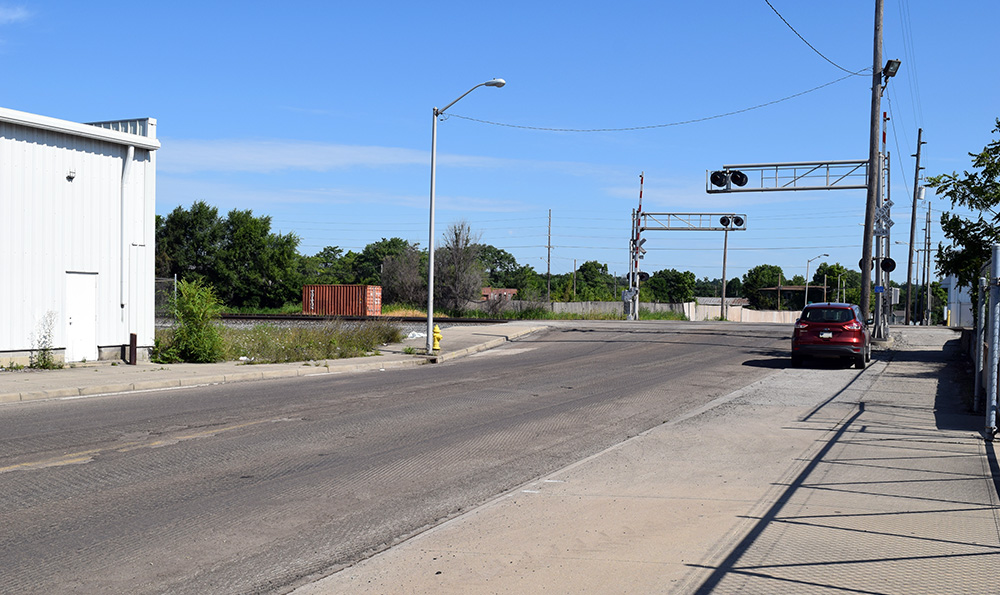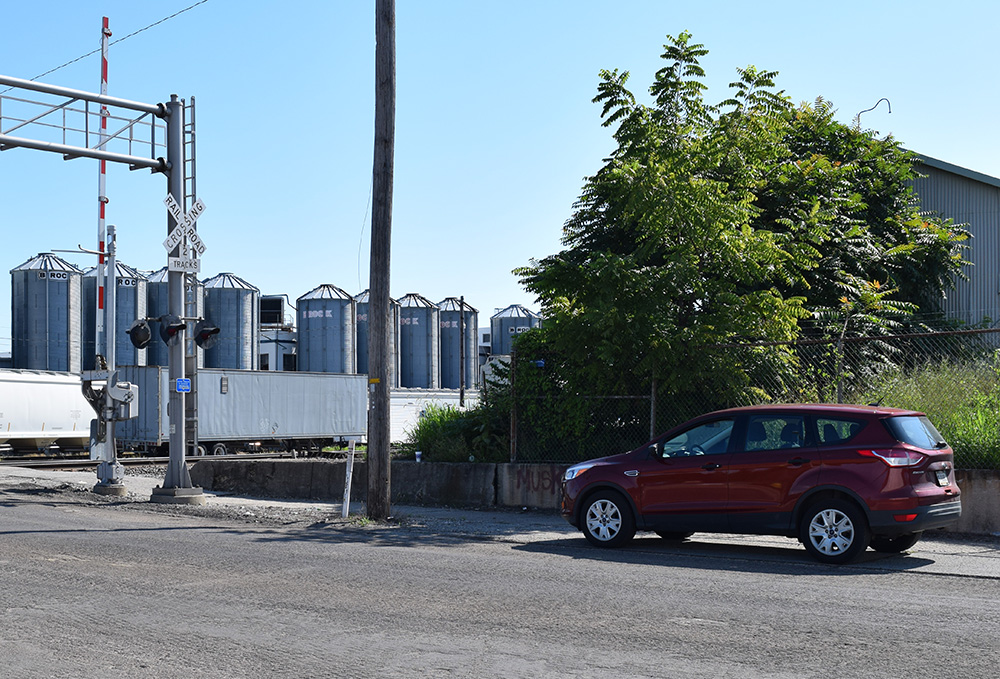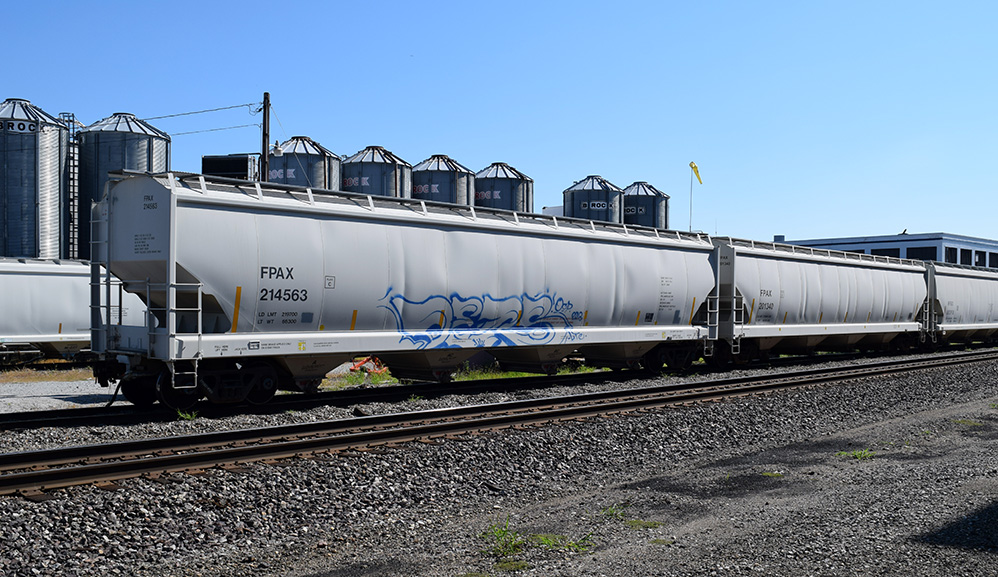
I’m Ready For My Cameo
No. 8166, a Norfolk Southern ES44AC set out a car on the lead for Industry One, then pulled clear of the turnout with the remaining cars as the conductor started his long walk to sort out the next move with the loads on Industry Two.
The brakeman lined the switch and the loco slowly shoved the cars toward 12th Street. Riding the lead car, the brakeman dropped down as the gates lowered and stood ready in case any idiot drivers couldn’t be bothered to stop.
Coupling up to the loads across the street, the engineer waited until everyone was in the clear, then shoved east a few more car lengths, bringing the locomotive into clear view from my position. It’s always a delight to study the intricacies of a modern diesel up close and simply listen to the myriad sounds as she idled away. The raking angle of the morning light highlighted every dent, ripple and seam in the sheet metal of each hopper car.
With the crossing now fully occupied, the patient people pulled up and waited all of five to ten seconds before turning around to find another way across. Parked in my usual spot, waiting wasn’t a problem as I was content to watch the story in front of me unfold.
From where I sat, buildings, fences and overgrown vegetation blocked the view down the tracks in both directions. I could have gotten out of the car and moved closer but I’m comfortable with not seeing everything at once. My field of vision only covered three or four car lengths and this tight focus allowed me to study and appreciate what was in front of me in a relaxed manner.
After a few minutes, the 8166 started her pull and brought all the loads out. How many varieties of covered hoppers are there now? Some I recognized, others I didn’t but what does it matter? I was too focused on the motion and cacophony of metallic groans and flange squeals to worry about such things. On such a long pull, the locomotive had to occupy the main at the other end of the yard and was well beyond 8th Street as the last car cleared the crossing at 12th.
Time was getting away and I had to move on. The gates raised and I waited my turn to pull out into traffic and then headed home. I didn’t need to stay. I know the story well and was content to simply watch it for a few minutes once again.
I enjoyed this scenario the other day. It’s what moves and inspires me about railroading but the criteria we use to model such a scene is likely to destroy any chance of capturing the satisfaction I felt while there.

Looking northeast, it’s easy to see how the overgrown vegetation and the end of the building blocks the view from where I’m parked. For a better view I usually sit on that low concrete retaining wall closer to the tracks.
What’s That You Say?
As a means of communication and expression, language is critical. Imagine going to a country where you don’t read or speak the language. You’d be unable to communicate with others or understand their attempts to speak to you. After a time you might figure out a few words or find a way to make do but the experience would be frustrating to put it mildly.
The process of design also has a language that, when used fluently, brings clarity and expression. Used poorly however, or in the wrong application, the same frustrating results occur. Communication and expression are hampered, if not shut down completely.
I find the hobby’s generic design principles limiting and unsatisfying. While there are many viewpoints about this, for me, the traditional language of layout design doesn’t provide what I want because it wasn’t designed to. These forms and tools are more suited to efficiently fit a given amount of track into a defined space but they do little else. To move beyond track planning one needs to learn a different language.
The process of design also has a language that, when used fluently, brings clarity and expression.

The raking angle of the morning light brings out every ripple in the sides of these hopper cars.
What I’m seeking is that immersive experience I have at the tracks. I want to feel a part of the scene not like I’m a drone hovering a hundred feet above it. My 13th and North E cameo gets me closer to this goal and although I conceived it to be operational initially, I now see it as more of a showcase for P48 modeling and in that role it doesn’t have to run.
Do We Really Need The Twisty Bits In Between?
My consistent experience has been staying in one location and watching a train do its thing. These impressions are strong and seem perfectly normal to me. Watching a single train at work is easy to understand. By contrast trying to take in the scope of interactions between multiple trains on the road feels like untying the Gordian knot. To this day, such operations are lost on me.
With those factors in mind, the design challenge to resolve centers on letting the strongest influences shine while eliminating the clutter, or to use my favorite analogy: tell a compelling story in a clear voice.
The cameo confirmed my preferences for a self-contained design that integrates important features such as lighting. I’m also pleased with what this form offers for composing a scene. Viewpoints and sightlines are easier to control and lighting can be placed anywhere. With LED technology there’s no reason why a single scene can’t have multiple light sources that create different effects. It’s more flexible than built in place construction with ceiling mounted lights and there are a lot of options I’ve yet to explore.
Any future layout I consider will be based on the idea of single scene cameos linked, if needed, by plain staging tracks. Based on my preferences and real world experiences, I see no reason to include the track or scenery in between such scenes. While the form is new to me, it’s quite common in other parts of the world and all of this is old news to those readers. Still the format isn’t that common in the US, where modeling concepts lag well behind what’s being done in the UK, Europe and elsewhere.
This format isn’t for every taste and isn’t meant to be. Think of it as the difference between an architect’s custom designed home that is seamlessly integrated into the site, with interior spaces that fit your needs exactly, versus a cookie-cutter tract house where you adapt your lifestyle to the existing rooms. Both are houses but they are a world apart.
Mike
0 Comments